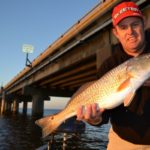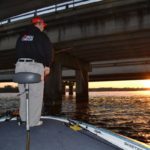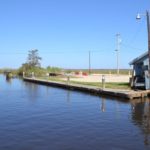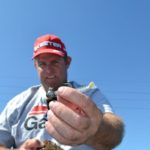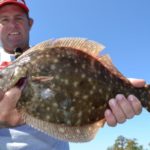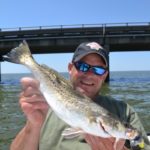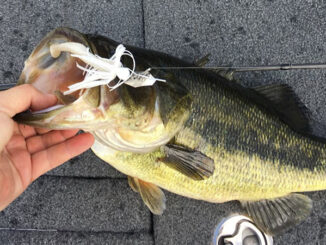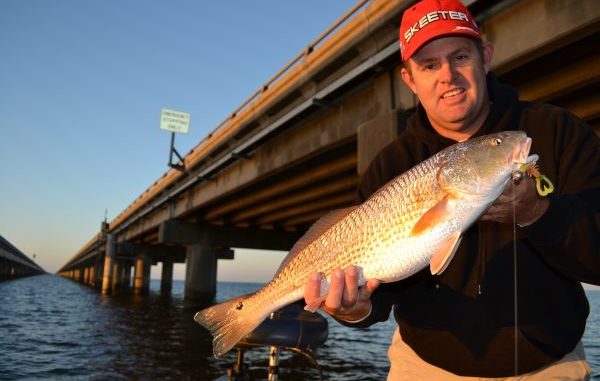
The lower Tchefuncte River provides easy access to speckled trout, redfish, black drum, flounder and plenty of largemouth bass.
There are certain anglers who wait for Internet reports to tell them where to fish. If an area heats up, they find out about it, and then they hitch up the boat to go share in the fun.
There are other anglers who like to be the ones producing those reports. They live on the cutting edge, and are the very anglers who discover hotspots and new techniques.
Jeff Bruhl fits into the latter group.
So it should have surprised no one that Bruhl launched his boat at Madisonville’s Marina del Ray early last October to see if the speckled trout had shown up on the Causeway. He hadn’t gotten any reports of good catches, but he just had a hunch that any day the fish would be stacked up higher than October cord wood.
“It’s usually not until World Series time — late October and into November — when the fish really show up here,” he said.
But a surprisingly chilly cold front for early October did the same thing to Bruhl that such Arctic surges do to whitetail bucks this time of year. Well, OK, maybe not the exact same thing. But the front did trip a trigger in Bruhl’s head, telling him that maybe — just maybe — the fish had moved to the Causeway early.
So Bruhl left the marina well before sunrise, and hooked a hard right at the mouth of the Tchefuncte River. After checking unsuccessfully for fish along the shoreline, he followed the watery channel out into the lake, and then angled toward his favorite speckled trout fishing spot.
The southbound span of the bridge was a buzz of activity, packed with commuters heading into the big city to earn enough to pay mortgages, car notes and tuition bills. The anglers among them certainly cursed the Skeeter bass boat speeding toward them on a Tuesday. Who the hell gets to fish on a Tuesday?
Bruhl, a Causeway regular from late October through May, hardly even noticed the traffic. The hum of the tires, the growl of the engines — to him, they’re like the throaty whistle of a redwing blackbird. As peaceful and serene as a white egret standing on a log.
An east-northeast wind limited Bruhl’s options, so he motored within a half mile of the north shore, and killed his 250-horse Yamaha.
Bruhl fished a molten-colored Gulp! Shrimp from the smelly Alive! liquid, and threaded it on his homemade ½-ounce jighead.
“I prefer 3/8(-ounce jigs), but if I’m out here hunting and want to fish a little faster, I’ll go with a ½-ounce jighead to get to the bottom quicker,” he said. “With a ½-ounce, you’re not spending much time letting the bait fall.
“Today, I’m just trying to figure out where the fish are. I’ll use a ½-ounce to throw, throw, throw and figure out where they are.”
Within the first 10 casts, he set the hook, and he could tell in an instant that it wasn’t one of his targeted speckled trout.
“Redfish,” he announced.
Bruhl exchanged tugs with the fish for three or four minutes, and brought to boatside a 23-inch red. Not a trout, but not a bad start to the day.
Just a few casts later, Bruhl was hoisting a flounder over the gunwale. Then a black drum. Then another flounder. Another redfish. And another flounder.
The fish were all in the first half mile of the bridge in water that was off-colored by Lake Pontchartrain standards. Visibility was about 1 ½ feet.
Bruhl decided to motor out as far as he could in the bumpy lake to the small hump called “the four-mile” in local parlance. Northshore anglers all measure the bridge from the north shore of Lake Pontchartrain, the mileage markers be damned.
“A little bit later in the year, the crossover loads up with flounder because of the lights,” Bruhl said. “They move to feed under the lights at night, and just stick around.”
Bruhl checked to see if they were there early, but like the speckled trout, they were apparently waiting for the American League and National League champions to be named.
He left the area, and motored back up to the first half mile, where the fish — even if they weren’t speckled trout — were thickest.
The Causeway stacks up with fish every year, and it’s only a matter of weeks — if not days — before the trout join the reds, flounder and drum there. Bruhl saw plenty of bait on the trip, and later in the day got reports of shrimpers dragging near the Tchefuncte River catching 4,000 pounds of white shrimp.
The specks were going to show up; it was just a matter of time.
But the Causeway has defeated more than its share of avid anglers. It’s a tough place to master, but Bruhl has some advice for people who want to jump ahead on the learning curve.
One is to do what he calls the reel technique. He recommends it for kids or anyone else who doesn’t have a lot of experience at the Causeway. In fact, Bruhl fishes this way frequently himself, and on many trips, it’s been the only way he could get fish to bite.
About a decade ago, he had his two sons out on the bridge, and he taught them the technique. They were reeling in fish faster than Bruhl could take them off.
An angler in a $60,000 Ranger bay boat stopped next to them and watched for a little while.
“He finally got disgusted, and said, ‘I can’t believe these kids are catching all these fish here, and I can’t get a bite,’” Bruhl recounted. “Before I could say anything and tell him how we were catching them, he stormed off heading back to the launch.”
Like many of the most-effective techniques, this one is simple.
“You basically just cast your jig out, and let it slow-sink to the bottom,” Bruhl instructed. “You’ve got to watch your line, and as soon as the slack hits, you’re on bottom.
“You keep your rod at about the 10 o’clock position, and just reel three or four cranks, and stop. Let your line go slack again. You’ll feel it hit the bottom, and then you reel three or four times again.
“Usually when you reel it the next time, you’ll never feel the tap. Your rod will just bow down. You just reel in and catch the fish.”
When Bruhl uses this technique — or any other — at the Causeway, it’s almost never to the same piling twice.
“The biggest mistake people make out here is they throw at the same spot 20 times,” he said. “They’ll catch a trout on this piling, and they’ll think there’s a school there, but out here, (the fish) are positioned because of the current around the pilings, and you can’t stack up 200 fish on one piling.
“Now, sometimes you will catch more than one fish from a piling, but usually, when I figure out where they’re sitting, I’ll make the same cast at each piling.”
That last part is really the key to cracking the Causeway code. It’s not surprising that bass fishermen typically do well fishing the bridge. Bruhl himself is an avid bass angler, competing in tournaments across the country and even providing a weekly bass report on the Outdoors with Don Dubuc radio show.
You’ve got to pay attention to how the fish are positioned in respect to the pilings. Bruhl makes mental notes of every bite, and is constantly adding the information to the formula in his head to determine the pattern for the day.
It’s not always as simple as casting to the downcurrent side of the pilings.
“Sometimes the tide’s rising on top and going out underneath, or it might just be strong enough that it’s all moving in one direction,” he said. “That fish is going to sit behind that piling waiting for bait to swim on either side. He’s just going to dart out and grab that baitfish. He’s in that eddy where he doesn’t have to work hard to get that bait when it comes by.
“So you have to figure out how he’s oriented. You don’t want to come from his tail. He’s not going to turn around and bite it. You’ve got to make sure you get the right angle. Sometimes boat position’s more important than anything.
“Once you figure out that one specific cast, just keep repeating it until you don’t get any more bites or you catch your limit of fish. It’s that simple.”
The length of the Causeway and its few anomalies are also intimidating for a lot of anglers. They don’t really know where to start when everything looks almost exactly the same for 24 miles.
Bruhl said the best way to find the fish when you’re going there blind is through simple trial and error.
“Usually if you get a good report, that’ll give you a good starting point,” he said. “Sometimes in the fall, they’ll be up close to the shoreline.
“But a lot of it is just going and fishing maybe 30 or 40 pilings, and then you move until you start getting bites. A lot of times, you’ll fish at the four-mile, and maybe catch just little ones or not get a bite. Then you go to the eight-mile, and all of a sudden, you start getting in the fish.”
The trout will be there any day, and Jeff Bruhl may just be the first one to catch them.
